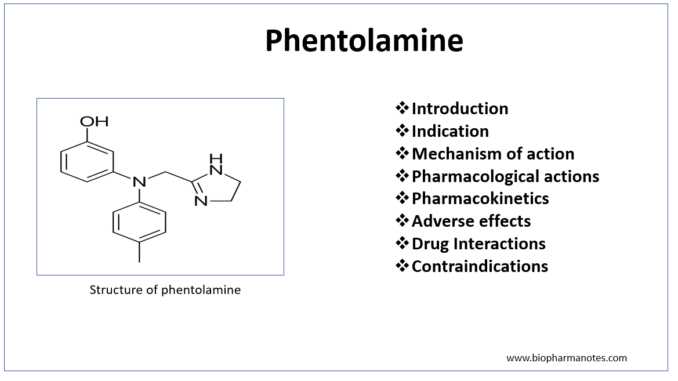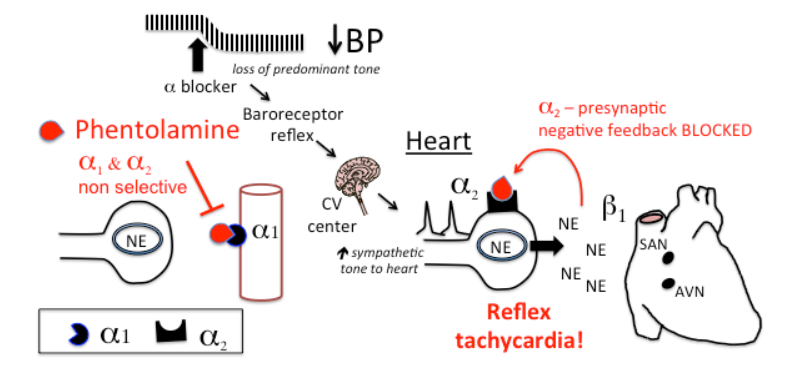
- Phentolamine is imidazoline derivative which causes competitive non-selective blockade of α- adrenergic receptors.
Indications of phentolamine
- Used in short -term control of hypertension or hypertensive emergencies in patients with pheochromocytoma. Also used in diagnosis of pheochromocytoma.
- In dental field to reverse effects of local anesthetic.
- To treat vasospasm of Raynaud’s disease and frost bite.
- Used in treatment of hypertensive crisis which may be cause due to abrupt withdrawal of clonidine or by ingestion of tyramine containing food during use of non- selective MAO inhibitors.
- In prevention and treatment of dermal necrosis.
- In treatment of erectile dysfunction.
Mechanism of action of phentolamine

Figure- Mechanism of action of phentolamine
Source- https://tmedweb.tulane.edu/pharmwiki/doku.php/phentolamine
- It competitively blocks α-1 and α-2 adrenergic receptors mainly excitatory response of smooth muscle and exocrine glands. This leads to muscle relaxation and dilatation of blood vessels resulting in lowering of blood pressure.
- It produces transient action and the blocking action produced by it is incomplete. It effectively antagonizes responses of circulating epinephrine and nor-epinephrine.
Pharmacological action of phentolamine
- Phentolamine causes dilation of peripheral blood vessels, primarily arterioles and capillaries of skin. It increases gut motility and gastric secretion and also increases respiratory, lacrimal, pancreatic and salivary secretion.
- It also causes blockade of β- adrenergic receptors which causes positive ionotropic and chronotropic effect on heart and increases cardiac output.
- Causes blockade of 5-HT receptors and stimulate histamine release from mast cells.
Pharmacokinetics
- It is administered through buccal, oral, IV or intracavernosal route. Absorption is poor when administered through oral route. About 1/10th of administered parenteral dose is excreted via urine. The remaining is metabolized.
- Half-life is very short, around 19 minutes. It has rapid onset of action (usually 2 minutes).
Adverse effects
- Hypotension is major side effect caused by phentolamine. It may also cause palpitation, flushing, headache, nausea, vomiting, diarrhea and epigastric distress.
- Excessive dose may cause tachycardia. Anginal chest pain and cardiac arrhythmia may occur.
Drug Interaction
- When used in combination with other alpha-adrenergic blocker like prazosin, it can produce synergistic effect. Hence such combination should be avoided. It may enhance hypotensive effect of CCB (calcium channel blocker).
- Its effect may decrease when used in combination with drugs like amphetamine and dapoxetine.
Contraindications
- Contraindicated in myocardial infarction or history of myocardial infarction.
- Contraindicated in patients allergic to phentolamine.
- Also contraindicated in coronary insufficiency, angina and other coronary artery disease.
- It should be used with caution in patients with history of peptic ulcer.
References
- https://accessmedicine.mhmedical.com/content.aspx?bookid=391§ionid=42070035
- https://pubchem.ncbi.nlm.nih.gov/compound/Phentolamine
- https://www.drugs.com/ppa/phentolamine.html#uses
- https://go.drugbank.com/drugs/DB00692
- Yan et al. Therapeutic efficacy of phentolamine in the management of severe hand, foot and mouth disease combined with pulmonary edema. Exp Ther Med. 2017; 13(4): 1403–1407.
- Goldstein I. Oral phentolamine: an alpha-1, alpha-2 adrenergic antagonist for the treatment of erectile dysfunction. International Journal of Impotence Research. 2000; 12: S75–S80.
- Pharmacology and Pharmacotherapeutics. 24th edition.
- Goodman and Gillman Manual of Pharmacology and Therapeutics.
- Essentials of Medical Pharmacology. 7th edition.